The AEMP Standard: Unlocking the Power of Mixed Fleet Telematics
What is it, How Can It Be Used, and What Are Its Benefits?
Table of Contents
- Executive Summary
- Introduction
- The Origins of the AEMP API
- How AEMP API increases profitability in the construction industry
- How Proemion delivers Mixed Fleet Telematics using AEMP API and third-party data
- Challenges in polling the right AEMP telematics data
- The future of AEMP API in Construction Telematics
- Next steps: implementing Proemion’s Mixed Fleet Solution
Executive Summary
This white paper provides a practical overview of the AEMP API and how it enhances both fleet management and OEM operations for off-highway heavy machinery. It explains how AEMP API standardizes telematics data, increases efficiency, and improves decision-making for businesses managing mixed fleets and OEMs looking to enhance their digital offerings.
We explore real-world applications, discuss how the AEMP API drives profitability, and address challenges related to data accuracy and availability. Additionally, we present how Proemion’s mixed fleet telematics solutions simplify the integration of AEMP data, ensuring actionable insights for both fleet managers and OEMs.
Why Read This?
- Learn how AEMP API helps reduce costs and optimize operations
- Discover how to overcome data inconsistencies in mixed fleet telematics
- Explore how OEMs can improve data accessibility and customer satisfaction
- See how Proemion’s solutions enable seamless telematics integration
Unlock the full potential of your mixed fleet—read on to see how!
Introduction
Efficient fleet management requires access to reliable, standardized telematics data. However, most OEMs provide proprietary telematics solutions, making it difficult to unify data across different machines. This results in inconsistent data, complicating fleet operations and decision-making.
For OEMs, the AEMP API (ISO 15143-3) presents an opportunity to standardize data, improve interoperability, and provide customers with enhanced telematics services. By offering AEMP API support, OEMs can not only meet industry expectations but also increase the adoption of their digital solutions, differentiate themselves from competitors, and drive new revenue streams.
The Origins of the AEMP API
The Association of Equipment Management Professionals (AEMP) developed the AEMP API to create a unified standard for fleet telematics data. Initially introduced in 2010 and later refined into an ISO standard in 2016, AEMP API ensures that construction equipment data is delivered in a common format, making it easier to integrate into mixed fleet telematics solutions.
While the AEMP API is widely adopted, compliance varies among OEMs, meaning fleet managers and OEMs must ensure proper data validation and integration strategies. By aligning with the AEMP standard, OEMs can enhance the value of their telematics services and strengthen customer relationships.
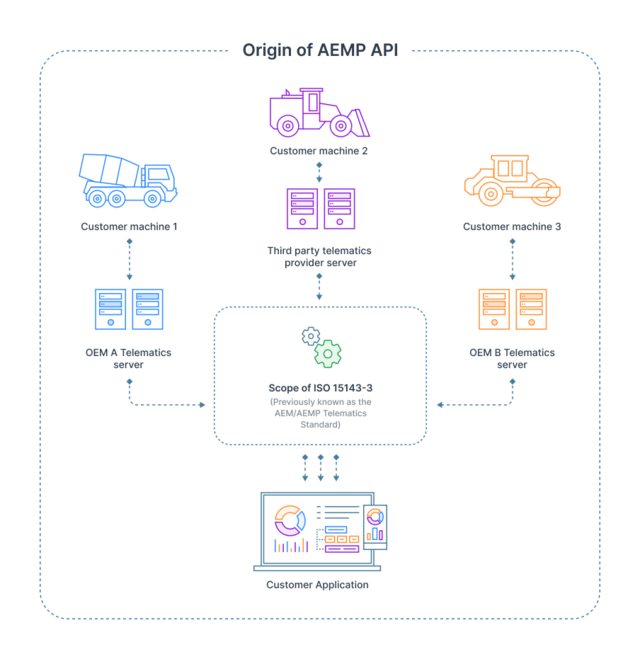
How AEMP API Increases Profitability in the Construction Industry
Businesses today face mounting pressure to increase efficiency while reducing costs. Implementing AEMP API-based telematics solutions enables construction companies and OEMs to:
- Optimize Machine Utilization – Reduce idle time and maximize operational output.
- Enhance Maintenance Planning – Use accurate data to prevent costly breakdowns.
- Improve Fuel Efficiency – Monitor and optimize fuel consumption to lower costs.
- Increase Workforce Productivity – Gain deeper insights into equipment usage.
- Improve OEM Service Offerings – Enable remote diagnostics and proactive support to enhance customer satisfaction.
Without AEMP API, managing a mixed fleet is fragmented and inefficient. With AEMP API, businesses and OEMs can unlock a streamlined, cost-effective approach to fleet management and telematics.
How Proemion Delivers Mixed Fleet Telematics Using AEMP API and Third-Party Data
Proemion’s Global Telematics Solution ensures seamless integration of AEMP API data by:
- Collecting standardized data from OEM cloud solutions
- Cleaning and validating data before processing
- Storing data securely in our DataPlatform
- Delivering actionable insights via DataPortal or external systems
By leveraging Proemion’s technology, companies can efficiently manage mixed fleets and automate key processes, eliminating the inefficiencies of manual data handling.
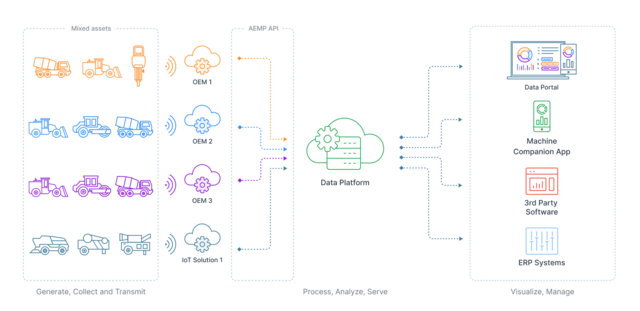
Challenges in Polling the Right AEMP Telematics Data
While AEMP API provides standardized data, challenges remain in:
To effectively utilize telematics data—especially for building use cases—the data must first be available. However, challenges with data availability don’t just exist at the OEM level; they can also vary between individual machine models from the same manufacturer.
For example, an OEM may provide operating hours data for some models but not others. This inconsistency means that even within a single OEM’s fleet, customers can’t always rely on receiving the same data across all machines. OEMs that fully adopt AEMP API standards can improve the reliability and accessibility of their telematics services.
Inaccurate telematics data leads to faulty predictions and unreliable use cases, ultimately wasting time, money, and resources. On the other hand, when use cases are built on accurate telematics data, businesses can make better decisions, improve efficiency, and reduce costs. Simply put, higher data accuracy translates to a better return on investment—without additional spending.
Errors in telematics data often stem from misconfigurations or technical issues within the machine’s system. While most data values are generally reliable, anomalies can distort analyses and render the data ineffective.
For example, certain counter metrics, like operating hours, should only increase over time. However, there have been cases where these values fluctuated up and down incorrectly. Although inaccurate data can often be corrected, it can disrupt reports and analytics until properly cleaned.
Thus, for OEMs, ensuring accurate telematics data ensures customer trust and reduces the burden of troubleshooting inaccurate insights.
Data frequency refers to how often information is retrieved from the OEM cloud, and it plays a crucial role in different telematics use cases.
Each use case has its own ideal update frequency. For instance, monitoring fuel consumption and planning refueling works best with hourly updates, whereas tracking operating hours for scheduled maintenance may only require weekly updates.
However, polling data every five minutes doesn’t guarantee new information at the same rate. A helpful analogy is an online Google Doc: imagine an OEM updating the document at irregular intervals—every 20 minutes, once an hour, or whenever they choose. Even if Proemion (or the machine owner) checks the document every five minutes, updates will only appear as often as the OEM provides them.
This limitation means that if an OEM only refreshes data once an hour, more frequent updates simply aren’t possible. While Proemion ensures data is accessible and structured, machine owners may need to request higher update frequencies directly from the OEM, as they ultimately own the data. By improving data update frequencies, OEMs can offer greater transparency and reliability in their telematics solutions.
At Proemion, we address these challenges by ensuring data validation, harmonization, and real-time accuracy across all connected assets.
The Future of AEMP API in Construction Telematics
The AEMP API helps both construction companies and OEMs optimize mixed fleet management by standardizing telematics data across different brands. This improves efficiency, reduces costs, and opens new business opportunities.
For OEMs, ensuring AEMP API compliance enhances machine compatibility, improves customer satisfaction, and strengthens brand loyalty by making fleet integration seamless.
Key Benefits of Standardized Telematics
- Data Consistency
- Lower Costs
- Higher Productivity
- Better Fuel Management
- Stronger Market Position
Typical use cases where the AEMP API can be integrated to good effect include:
Regular servicing is critical to prevent breakdowns and extend machine lifespan. By tracking operating hours, fleet managers can schedule maintenance proactively. For example, if a machine requires servicing every 500 hours, a maintenance ticket can be created at 450 hours, ensuring timely servicing without disrupting operations. OEMs that provide accurate and frequent operating hour data help customers optimize maintenance scheduling, reducing unexpected downtime.
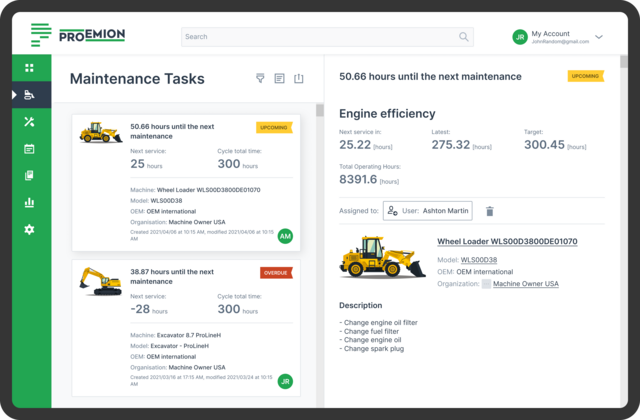
Fuel is one of the highest operational costs in fleet management. With AEMP API, businesses can monitor fuel consumption, track refueling needs, and optimize fuel efficiency. Frequent data updates allow for better fuel usage analysis, supplier coordination, and cost control. OEMs that deliver precise fuel data empower fleet owners to make smarter refueling decisions and reduce waste.
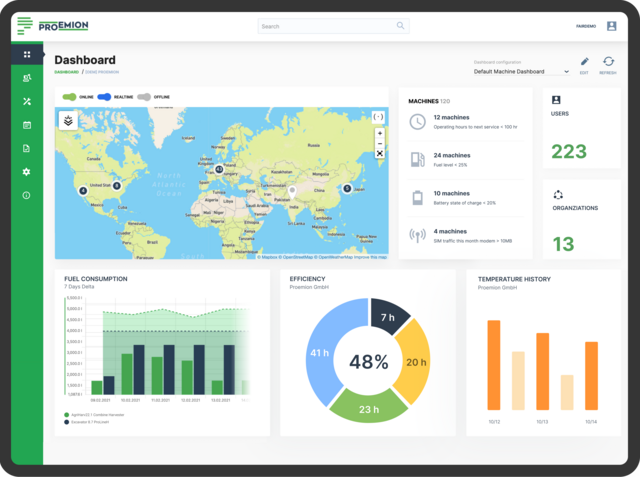
Knowing the real-time location of machines is essential for relocation and dispatching. Construction and rental companies frequently move equipment between job sites and must ensure transporters pick up the right machine at the correct location. GPS data updated every 1-2 hours helps avoid costly delays, improves logistics, and ensures seamless project execution. OEMs providing consistent location data add significant value to their machines by enabling better fleet coordination.
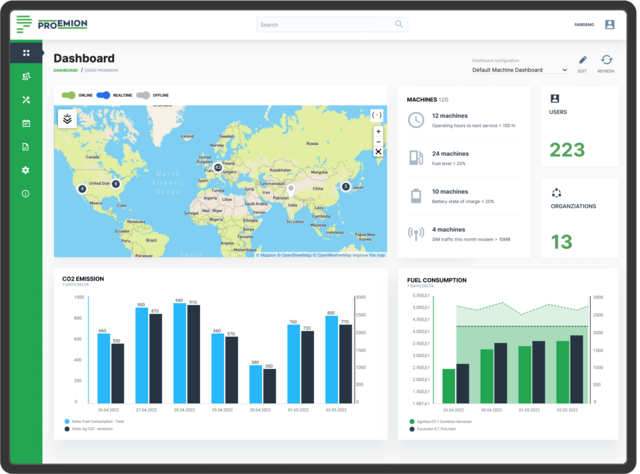
With Proemion’s ongoing commitment to innovation, we ensure that our solutions remain at the cutting edge of telematics technology.
Next Steps: Implementing Proemion’s Mixed Fleet Solution
Implementing AEMP API successfully requires an experienced telematics partner. Proemion provides end-to-end solutions that benefit both fleet managers and OEMs by enhancing data accessibility, accuracy, and usability.
How Proemion Supports Your Business:
For Fleet Managers – Gain a unified view of mixed-fleet data, automate workflows, and optimize machine utilization.
For OEMs – Enhance customer value by delivering high-quality, standardized telematics data and improving service offerings.
Proemion simplifies this process through:
- Consultation & Solution Design – Developing tailored strategies for telematics integration.
- Seamless API Integration – Enabling smooth data exchange between OEM platforms and fleet management systems.
- Ongoing Data Accuracy Optimization – Ensuring reliable insights for better decision-making.
Whether you are an OEM looking to expand your telematics capabilities or a fleet manager seeking greater control over operations, Proemion provides the expertise and technology to make it happen.